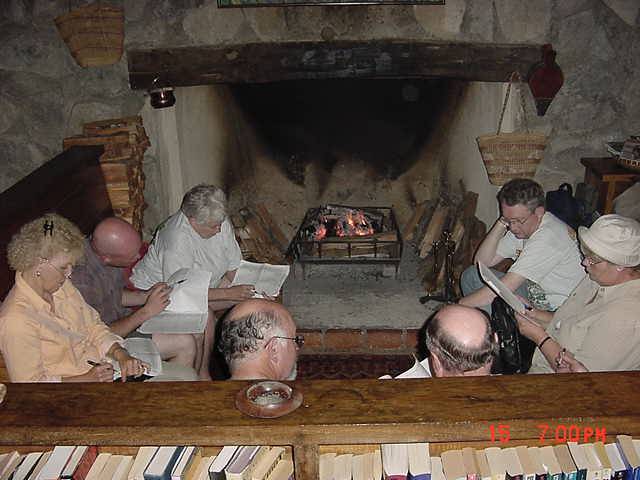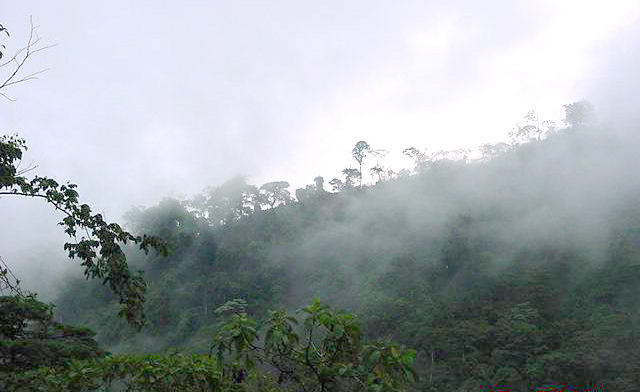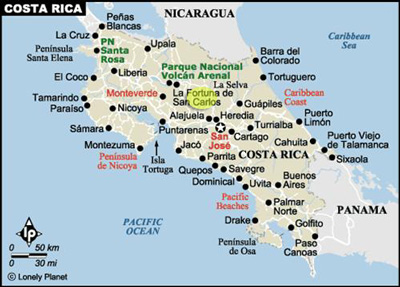
Costa Rican Birding Adventure Part 5—Poas Volcano Area |
|
| La Paz Waterfall Reluctantly we bade farewell to the bird-rich area of Selva Verde at something like 500 feet elevation and headed south up toward the Poas Volcano where we’d be above 5,000 feet. We had paved roads all the way—albeit somewhat narrow, steep, and winding. We stopped at a little Mirador roadside stand near the La Paz Waterfall where Red-faced Barbet often is found. Unfortunately, not this time. But we did get to handle a couple of friendly tarantulas (what great looks on Carol Jean’s and LeIla’s faces) and a huge Hercules Beetle. Dennis purchased the beetle to add to his growing collection. Hummingbird feeders and a couple of fruit feeders were placed outside a covered porch with chairs and a great view of the waterfall. Here we saw the Green Thorntail (hummingbird) with a long, jagged tail, Brown Violetear, Violet Saberwing and several other familiar hummers. A large, black and green hummingbird flew in—a Magnificent Hummingbird, a common hummer in southeastern Arizona and even accidental in Utah. Down at the fruit feeders a beautiful yellow Silver-throated Tanager sampled a banana. I finally got a good look at one of our favorite birds of the trip, the colorful Bay-headed Tanager. A couple of Emerald Toucanets worked the tree below us. We bought some soft drinks and made a donation to help them keep the sugar water and fruit in stock for the birds. Driving further up the mountains, we stopped at a stream crossing to find
old friends from Utah: American Dipper and Black Phoebe. At
the second crossing, we finally found our main target—Torrent Tyrannulet.
This little gray and black flycatcher lives very close to streams and,
somewhat dipper-like, often perches on rocks in the middle of the current to
look for insects above (as opposed to under) the water. The two we found
were evidently nesting under the moss on the side of the bridge abutment.
|
|
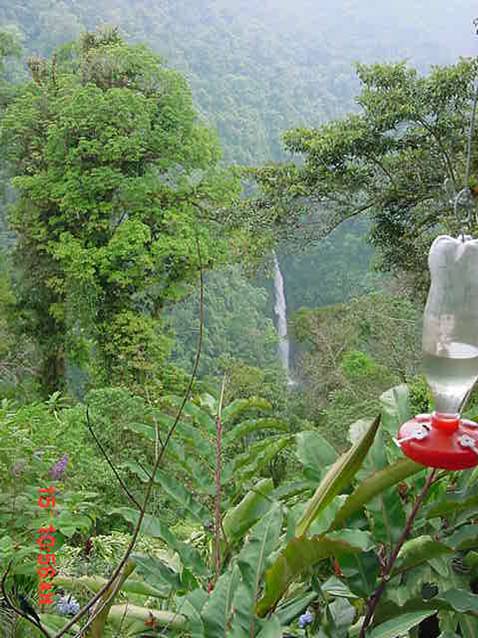 |
|
|
La Paz
Waterfall by Ned Hill |
|
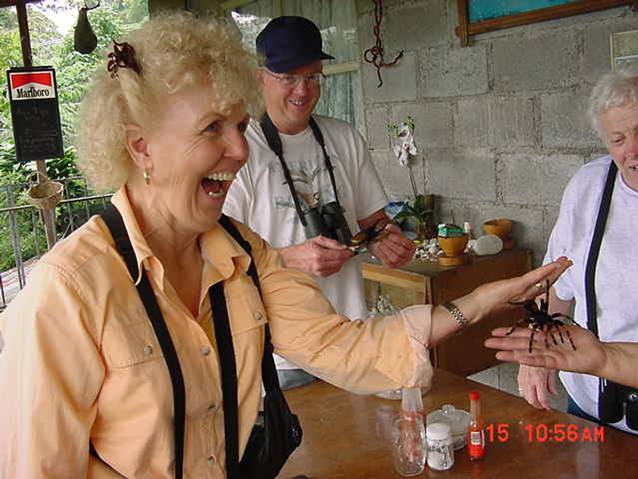 |
|
|
La Paz Tarantula by Ned Hill |
|
|
|
Poas Volcano Lodge We finally reached the comfortable Poas Volcano Lodge—an attractive stone and cement manor house that was turned into a lodge by its British owner. The original family farmed the area. Milton and I shared a room—a rather small one with beds that were about 5’ 10" and we are both over 6 feet tall. The air was cool and the clouds were thick preventing us from seeing the volcano that is some distance away and at a much higher elevation. As we unpacked the van, a Slaty Flower-piercer darted among the flowers like a hummingbird. It has an upturned beak with a hook at the end that enables it to pierce into the base of the flower and drink the nectar—a hummer with a shortcut! It’s not much larger than a hummingbird—only about 4". After unpacking, we drove back down the mountain to a deep gorge called Virgen del Socorro. The road is above the gorge so we were looking down at the tops of the trees. Unfortunately, it started pouring rain so we jumped back into the van and drove to the Mirador roadside stand again where we could be sheltered. The clouds in the valley were spectacular. No new birds—the barbet didn’t show again. The rain stopped in a few minutes so we drove back to Virgen del Socorro. It is amazing that rain has only delayed us a total of 20 minutes all week long in this very wet country. As we hiked down the road overlooking the gorge, Dennis and I got a perfect look at the Bay-headed Tanager. One flew across the road and landed on a branch not 20’ away. With the red earth as a backdrop, the turquoise colors of the breast and the green of the back really stood out. Some saw a Spectacled Tanager working high in the trees. We found a Smoky-brown Woodpecker climbing a trunk and a Mountain Elaenia (a flycatcher) in the leaves. We finally identified some White-collared Swifts soaring over the gorge. Their white collars became visible as they banked against the green of the far side of the gorge. A beautiful Collared Trogon perched in a tree high above us and another called further up the hill. We also heard the amazing song of the Nightingale Wren that sounds like someone whistling completely random notes. Tuula was further up the hill than the rest of us. When she approached the van, she saw a couple of Chestnut-capped Ground Finches but the rest of us missed them. We saw here a number of wintering warblers from North America: Chestnut-sided, Tennessee, Golden-winged, Yellow, and Blackburnian. We have seen many of these throughout the trip but I have not mentioned them too often. We compiled our list by a roaring fire in the lodge and enjoyed an excellent dinner prepared by the lodge staff. As Tom had an 8:00 a.m. flight the next morning, Bryan drove him down to the airport after dinner. We’ll miss Tom’s dry wit and great conversation. The rest of us went out to listen for Dusky Nightjar but couldn’t hear anything in the wind. We also tried playing a few owl calls but got no response. A couple of us felt a bit sick on this final night—was it the food at that roadside stand? Up at early to greet our last day. The plane leaves at around 2 o’clock for most of the group but that leaves us a couple of hours to find some of the unique species that are only found at this higher elevation. With good old Imodium and orange juice, I was feeling better after a rough night. Bryan spent the night near the airport but arose very early to rejoin us before breakfast. We walked around the lodge grounds for an hour or so and were able to locate Black-billed and Orange-billed Nightingale Thrushes. A tiny hummer coming into the flowers was a Scintillant Hummingbird. While we ate breakfast, an Emerald Toucanet flew onto the fruit
feeder. We showed the non-birding guests at the lodge and loaned them our
binoculars for a look. They were amazed at the beauty of this stunning green
bird. Then a Flame-colored Tanager took its place at the
feeder—"flame" being a most appropriate name for its color. The non-birders
joined us in "ooing and awing" at the display. Even a Golden-browed
Chlorophonia briefly made an appearance at the feeder—wow, what a trio
of spectacular birds. I think our guests were converted to birding on the
spot. Before we packed the van, we found Mountain Elaenia again in
the trees below the lodge. |
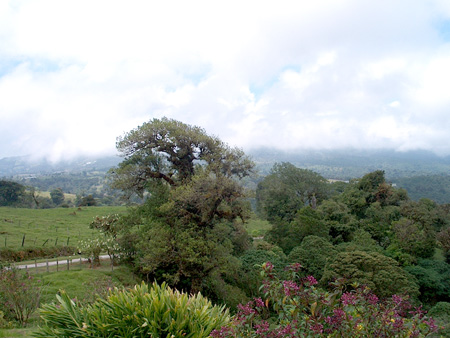 |
|
|
View from Poas Lodge by Tom Williams
|
|
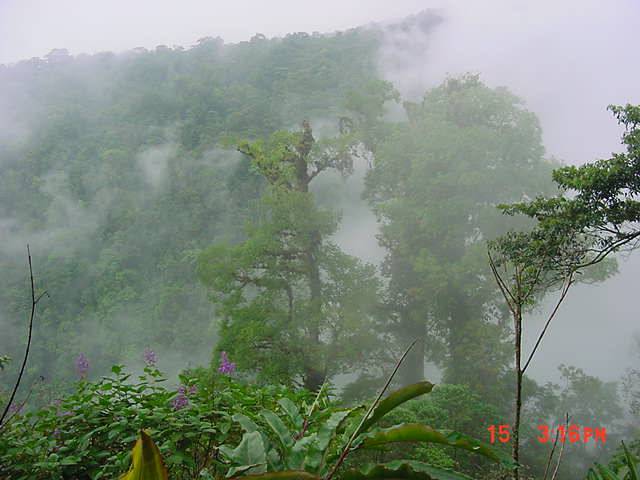 |
|
|
Cloud Forest Defined by Ned Hill
|
|
|
|
|
|
Doing the Birdlist by the Fire
by Ned Hill
|
|
|
|
|
|
Farewell to Costa Rica |
|
|
|
|
|
Costa Rica by Ned Hill |
|
|
At the airport in Alajuela, we bade our farewells. Carol Jean went to Delta, Bryan went back to the van (he remained in Costa Rica for a few more days), I went to find a shuttle to the Marriott (I went on to Panama, Colombia and Ecuador on BYU business) and the rest boarded a Continental flight through Houston to Salt Lake City. It was a wonderful trip in every way. One could not ask for a more compatible group of people characterized by patience, good humor, helpfulness, energy, and enthusiasm for birds. Bryan and Dennis were outstanding guides. They worked very hard to provide for our every need—especially seeing birds. We tallied about 300 birds and many other amazing plants and animals. We came to appreciate ever more fully the wonder of Heavenly Father’s creation. We grew to also appreciate the friendship of the good people of Costa Rica and their efforts to save their forests for plants and animals. They have found that it pays to protect the ecosystem—people all over the world come here to enjoy the natural heritage they have created. We all hoped we’d be able to return in the not too distant future. The End
|
|
|
|
|
